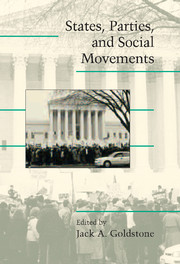Book contents
- Frontmatter
- Contents
- List of Figures and Tables
- Foreword
- Acknowledgments
- Contributors
- INTRODUCTION: BRIDGING INSTITUTIONALIZED AND NONINSTITUTIONALIZED POLITICS
- I States and Social Movements
- 1 COUNTERMOVEMENTS, THE STATE, AND THE INTENSITY OF RACIAL CONTENTION IN THE AMERICAN SOUTH
- 2 STATE VERSUS SOCIAL MOVEMENT: FBI COUNTERINTELLIGENCE AGAINST THE NEW LEFT
- 3 SETTING THE STATE'S AGENDA: CHURCH-BASED COMMUNITY ORGANIZATIONS IN AMERICAN URBAN POLITICS
- 4 STATE PACTS, ELITES, AND SOCIAL MOVEMENTS IN MEXICO'S TRANSITION TO DEMOCRACY
- II Parties and Social Movements
- Afterword: Agendas for Students of Social Movements
- References
- Index
2 - STATE VERSUS SOCIAL MOVEMENT: FBI COUNTERINTELLIGENCE AGAINST THE NEW LEFT
Published online by Cambridge University Press: 26 February 2010
- Frontmatter
- Contents
- List of Figures and Tables
- Foreword
- Acknowledgments
- Contributors
- INTRODUCTION: BRIDGING INSTITUTIONALIZED AND NONINSTITUTIONALIZED POLITICS
- I States and Social Movements
- 1 COUNTERMOVEMENTS, THE STATE, AND THE INTENSITY OF RACIAL CONTENTION IN THE AMERICAN SOUTH
- 2 STATE VERSUS SOCIAL MOVEMENT: FBI COUNTERINTELLIGENCE AGAINST THE NEW LEFT
- 3 SETTING THE STATE'S AGENDA: CHURCH-BASED COMMUNITY ORGANIZATIONS IN AMERICAN URBAN POLITICS
- 4 STATE PACTS, ELITES, AND SOCIAL MOVEMENTS IN MEXICO'S TRANSITION TO DEMOCRACY
- II Parties and Social Movements
- Afterword: Agendas for Students of Social Movements
- References
- Index
Summary
The social movement literature has been most concerned with explaining how individuals come to be participants in movements and how these movements mobilize resources to achieve their goals. A key insight in this literature is that movements are incredibly fragile. Studies that have simulated the growth of movements under various conditions consistently find that small changes in the distribution of interests, the level of connectedness within the targeted population, or the amount of resources held by particular key individuals can drastically alter outcomes (see Granovetter 1978; Kim & Bearman 1997; Marwell & Oliver 1993). It is clear that this fragility is recognized by those who seek to oppose these movements. The fact that these opponents act on this recognition, often with a devastating effect on movements, is most clearly evidenced in totalitarian states by the existence of terror. Modern democratic states engage in repressive strategies as well, though usually more subtly through attempts to disrupt the organizational structure of protest groups.
Despite the important role played by those who oppose movements, social movement researchers have largely ignored this dimension, paying only tacit attention to how repression is allocated (although, for exceptions, see Davenport 2000; Tilly 1978). This essay contends that to capture more fully how repression affects protest movements, we need to understand how authorities organize and allocate repression. The particular context I examine here is the United States between 1961 and 1971.
- Type
- Chapter
- Information
- States, Parties, and Social Movements , pp. 45 - 77Publisher: Cambridge University PressPrint publication year: 2003
- 12
- Cited by



